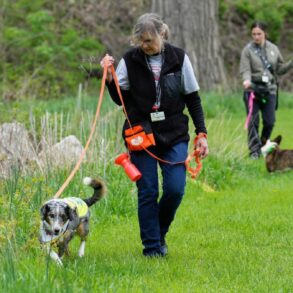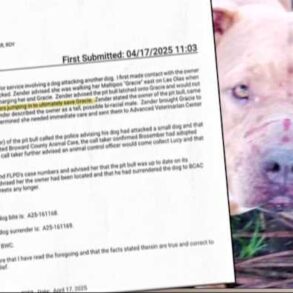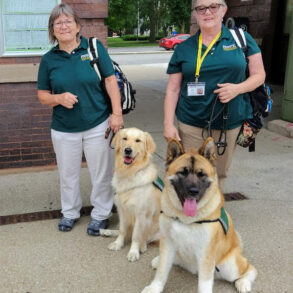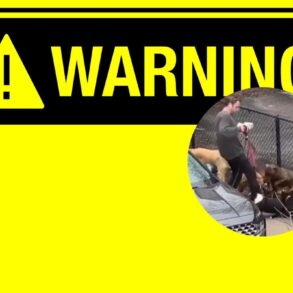Juno quietly takes a treat from her mom after an hour’s work sniffing out spotted lanternfly eggs on trees in the Cleveland Metroparks.
“She’s not a volunteer, she gets paid.… I’m just the chauffeur,” Tara Gifford said.
Gifford, along with Argent and his human, Ginger Alpine, are volunteers on a team working on sniffing out spotted lanternfly eggs on park trees in the Ohio & Erie Canal Reservation in Cuyahoga Heights.
Spotted lanternflies are an invasive species native to Asia that have traveled to the United States through the transport of imported products. The lanternflies don’t bite, but they damage food crops, including local fruit and hardwood trees.
The dogs, all of whom have previous training to sniff out scents, are selected and then trained through a federally funded research program at Virginia Tech to sniff out spotted lanternfly eggs. When the dogs find eggs, they alert their humans, who use a paint scraper duct-taped to the end of a pole to scrape the egg patches off the tree bark and squish them onto the ground.
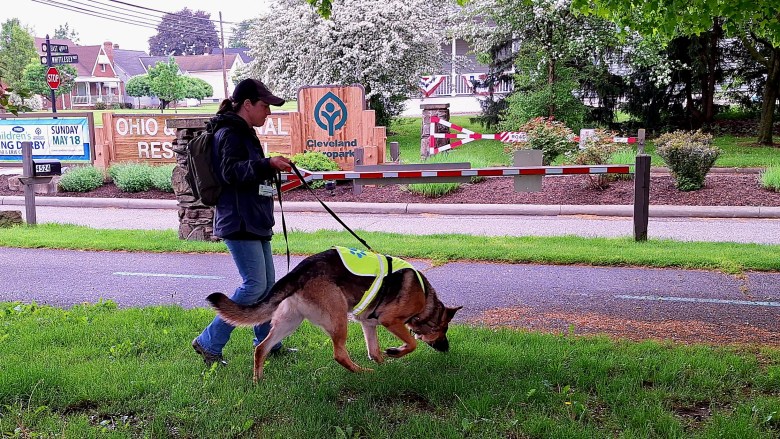

Scraping your spotted lanternfly eggs before they hatch
Area residents have until about the end of May to get out in backyards and scrape spotted lanternfly egg masses from trees, said Cleveland Metroparks Senior Conservation Science Manager Connie Hausman.
Spotted lanternfly eggs begin hatching in spring, usually April to May. The juvenile lanternflies go through four stages of growth before emerging as adults in July and August. Adult lanternflies mate between August and October, when the females will start laying their eggs. The egg masses are visible between October and April, even through winter.
“It’s a very large, long window in which the egg masses are developing,” said Hausman.


Metroparks volunteers use their special scrapers to reach high up into trees, but the soft egg masses can be scraped off with just a plastic card.
“I actually use an expired Starbucks gift card,” said Hausman. “You will be squishing egg masses, so it can get sticky. It can get messy. So, you know, find something like an expired gift card, or a putty knife or a small hand tool that most people have.”
Hausman said the lanternflies seem to favor species of trees that have smoother bark, like maples. You can scrape the egg masses onto the ground and squish them. Some people scrape them into a bucket of soapy water.
“They’re easy to spot,” said Hausman. “They look like a wad of mud, or like, silly putty, if you took silly putty and just squished it on a tree, a couple inches long and about an inch wide.”

Egg scraping is easy to do and requires little more effort than walking into your own yard. Hausman suggested checking patio furniture and picnic tables or stacks of firewood. “They will lay their egg masses on anything … people enjoy their backyard, and so they need to take an active approach to searching there so the bug doesn’t further compromise having picnics and parties and make a mess of their backyard.
“They’re not native around here, so there’s no evolved natural predators,” added Hausman. “There is some research into some possible, you know, pathogens that might be able to be introduced or birds that may eat them, but it’s definitely not going to be anything that could control the population.”
Microphone windscreens look like dog toys and other lessons learned from Juno and Argent
Signal Cleveland Reporter Gennifer Harding-Gosnell interviewed Juno Gifford and Argent Alpine and their owners on their sniffing shift at the Ohio & Erie Canal Reservation on East 49th Street in Cuyahoga Heights.
Listen in to this Signal Soundscape as Argent sniffs out an egg mass and Juno realizes the microphone windscreen looks like a fuzzy dog toy:
This post was originally published on this site be sure to check out more of their content.











